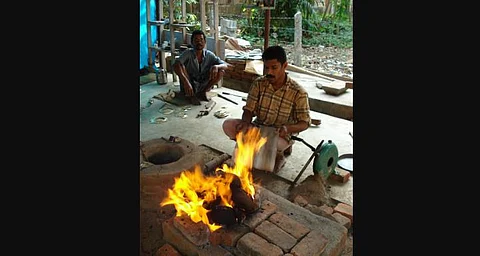

An iconic sculpture from Karnataka is of the madanika or damsel from the 12th century Hoysala Belur temple. Attributed to the patronage of dancer and queen Shantala Devi, she gazes engrossedly into a mirror and forms part of a stone imitation of an architectural strut. Apart from aesthetic significance related to personal adornment, mirrors have also had magico-religious associations in various parts of Asia. The English word ‘speculation’ was derived from the Roman ‘speculum’, related to foretelling the future by looking into a mirror. This was also taught to students of Tibetan Buddhism. The fascinating Chinese magic mirrors made of bronze had a mercury-coated reflective surface that could throw patterns on a wall related to the decorated rear surface due to intriguing optical effects.
While the lush green village of Aranmula in Kerala along the languid Pampa river comes alive during Onam festivities with a frenzy of boat races, its alluvial loam also nurtured a remarkable craft of mirrors known as Val Kannadi (Malayalam/Tamil; kanne being related to sight). The freshly polished Aranmula metal mirrors yield an astounding reflective image which can even legitimately claim to be better than modern mirrors. Whereas modern mirrors have a thin sheet of glass over a reflective mercury coating, with refraction through glass diminishing the quality, the Aranmula metal mirror gives a perfect point image due to the absence of such refraction, with brilliant colours due to uniform reflectance across the surface. Metallurgical investigations by the author over the past few decades on remnants collected from traditional Acharis or master craftspeople contributed to revealing how the spectacular reflectance was achieved.
Ancient Egyptian as well as Harappan mirrors excavated from Quetta and Dholavira were flat, circular or oval with tangs and appear to have been of copper or bronze with a low amount of tin. Although copper and bronze can give a polished reflective surface, the image would have a more golden or coppery hue rather than true colours. Whereas silver has good reflectance, it is soft and prone to denting or scratching, which would yield distorted images. This is why early Belgian mirrors were of glass over a silver layer, although the silver tarnished over time and was eventually replaced by more durable mercury coatings.
The Aranmula alloy seems ideal for mirrors as it consists predominantly of a highly reflective delta phase that is an intermetallic compound of 32.6% tin bronze, forming a narrow composition range of 32-33% tin alloyed to copper. This silvery-white compound has a very high hardness of 500 VPN more than steel and hence yields itself to being polished free of distortion to get the best possible reflective surface. The challenge is that the alloy is brittle and breaks as easily as glass, and hence the skill of the traditional craftspeople lay in the ingenious methods of casting and manipulating the alloy using low-tech materials to get a high-tech product.
To offset the brittleness, a very thin oval blank of a couple of millimetres was cast so that it would cool more rapidly and homogeneously. A closed crucible-cum-mould was used, whereby the bottom part consisted of a two-piece mould kept a few millimetres apart into which the mirror blank would be cast, and the top had a cup containing the metal to be cast. This apparatus was then sealed with clay, forming a closed crucible that could minimise the interaction of air and molten metal, which could cause a defective casting. It was then heated in a hearth with the crucible cup facing downwards and then the molten metal tipped over; thermal camera studies suggest a temperature difference between crucible cup and mould that facilitated more rapid cooling of the mirror blank. The cast blank was then skilfully lapped over a few days, in much the same way that modern metallurgical samples are polished—traditionally with coarse polishing on a rougher gunny sack and then using Hessian cloth to remove finer scratches, until a brilliant mirror finish was obtained.
Although mirrors were made in antiquity with over 20% tin such as in China or the Roman world, they often had lead added to reduce the brittleness. However, lead, being opaque, could reduce the reflective properties compared to the unleaded Aranmula delta bronze mirror. Indeed, a mirror from Kerala with a Travancore seal of the 18th century examined by the author remarkably consisted almost entirely of pure delta phase crystals. Cairns going back to the Iron Age from the Nilgiris also intriguingly yielded a mirror with 30% tin bronze as reported by Breeks in the 19th century. Speculum metal with about 30% tin and perhaps a few per cent lead was used for telescopic lenses, for example by the astronomer William Herschel from Bath, UK, in the 18th–19th century. One might joke that the Aranmula mirror could be an ideal material for a reflective telescope in space where it would not corrode due to the lack of atmosphere! However, on earth it does tarnish over time and the craftspeople recommend frequent polishing with red oxide to keep the mirror effect going. After the demise of master craftspeople such as Janardhan Achary and Gopalakrishna Achary, it is heartening that their enterprising daughters and spouses have striven to keep alive the fading legacies.
Sharada Srinivasan
Professor, School of Humanities, National Institute of Advanced Studies, Bengaluru
(sharadasrini@nias.res.in)